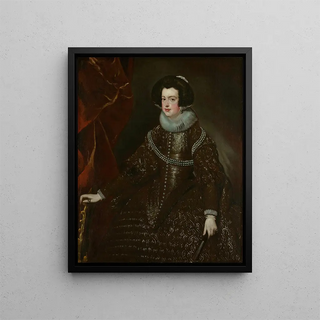Art print | Isabelle de Bourbon, wife of Philip IV of Spain - School of Diego Velázquez Source: Reproduction | Isabelle de Bourbon, épouse de Philippe IV d'Espagne - École de Diego Velázquez


View from behind

Frame (optional)
Isabelle de Bourbon, wife of Philip IV of Spain - School of Diego Velázquez – Captivating Introduction
The artwork "Isabelle de Bourbon, wife of Philip IV of Spain" is a shining example of the artistic mastery of the School of Diego Velázquez. This portrait, which captures the very essence of 17th-century Spanish nobility, transports us to a world where beauty and power meet. Through the delicate features of Isabelle, one perceives not only a court lady but also an iconic figure of an era marked by political tensions and artistic aspirations. This painting, full of nuances and light, invites us to explore the subtleties of aristocratic life while revealing the talents of an artist who transcended his time.
Style and uniqueness of the artwork
The piece stands out for its baroque style, characterized by a subtle treatment of light and shadow. Velázquez, a true virtuoso, plays with reflections and textures, bringing to life the silk of Isabelle's dress and the brilliance of her jewelry. The composition is carefully balanced, highlighting the figure of the queen while integrating elements of her environment. Every detail, from the richly decorated background to the delicate accessories, contributes to creating an atmosphere of grandeur and elegance. This portrait does not merely depict a woman; it tells a story, that of a time when painting was a powerful vehicle of communication and propaganda.
The artist and his influence
Diego Velázquez, born in 1599, is undoubtedly one of the masters of Spanish painting. His work, marked by meticulous observation and an innovative approach, has profoundly influenced generations of artists who followed. Velázquez knew how to capture the soul of his subjects, going beyond simple realism to explore human psychology. His influence is felt not only in the Spanish art world but also internationally, inspiring artists such as Édouard Manet and Pablo Picasso. By painting royal figures and scenes of everyday life, Velázquez redefined the portrait as a genre, endowing it with emotional depth that continues to move viewers today.
A wall decoration

Matte finish

View from behind

Frame (optional)
Isabelle de Bourbon, wife of Philip IV of Spain - School of Diego Velázquez – Captivating Introduction
The artwork "Isabelle de Bourbon, wife of Philip IV of Spain" is a shining example of the artistic mastery of the School of Diego Velázquez. This portrait, which captures the very essence of 17th-century Spanish nobility, transports us to a world where beauty and power meet. Through the delicate features of Isabelle, one perceives not only a court lady but also an iconic figure of an era marked by political tensions and artistic aspirations. This painting, full of nuances and light, invites us to explore the subtleties of aristocratic life while revealing the talents of an artist who transcended his time.
Style and uniqueness of the artwork
The piece stands out for its baroque style, characterized by a subtle treatment of light and shadow. Velázquez, a true virtuoso, plays with reflections and textures, bringing to life the silk of Isabelle's dress and the brilliance of her jewelry. The composition is carefully balanced, highlighting the figure of the queen while integrating elements of her environment. Every detail, from the richly decorated background to the delicate accessories, contributes to creating an atmosphere of grandeur and elegance. This portrait does not merely depict a woman; it tells a story, that of a time when painting was a powerful vehicle of communication and propaganda.
The artist and his influence
Diego Velázquez, born in 1599, is undoubtedly one of the masters of Spanish painting. His work, marked by meticulous observation and an innovative approach, has profoundly influenced generations of artists who followed. Velázquez knew how to capture the soul of his subjects, going beyond simple realism to explore human psychology. His influence is felt not only in the Spanish art world but also internationally, inspiring artists such as Édouard Manet and Pablo Picasso. By painting royal figures and scenes of everyday life, Velázquez redefined the portrait as a genre, endowing it with emotional depth that continues to move viewers today.
A wall decoration






